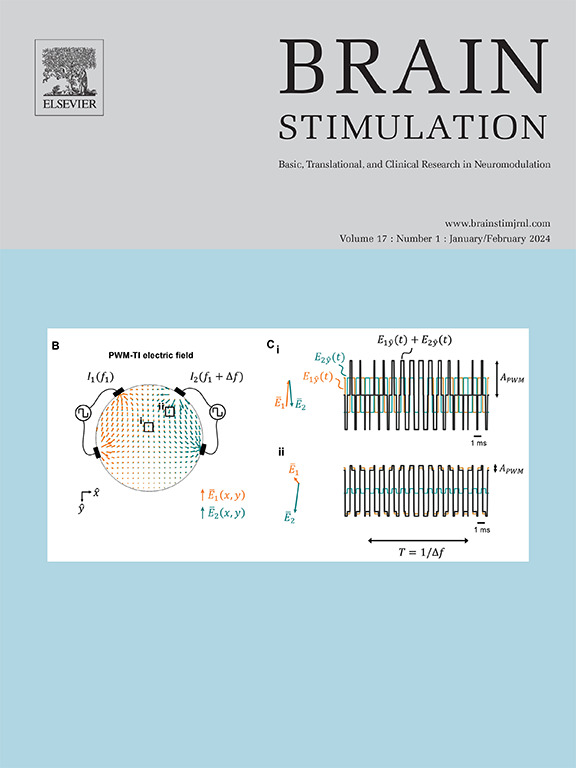Does transcutaneous auricular vagus nerve stimulation alter pupil dilation? A living Bayesian meta-analysis
IF 7.6
1区 医学
Q1 CLINICAL NEUROLOGY
引用次数: 0
Abstract
Background
Transcutaneous vagus nerve stimulation (tVNS) has emerged as a promising technique to modulate autonomic functions, and pupil dilation has been recognized as a promising biomarker for tVNS-induced monoaminergic release. Nevertheless, studies on the effectiveness of various tVNS protocols have produced heterogeneous results on pupil dilation to date.
Methods
Here, we synthesize the existing evidence and compare conventional (“continuous”) and pulsed stimulation protocols using a Bayesian meta-analysis. To maintain a living version, we developed a Shiny App with the possibility to incorporate newly published studies in the future. Based on a systematic review, we included 18 studies (N = 771) applying either conventional or pulsed stimulation protocols.
Results
Across studies, we found anecdotal evidence for the null hypothesis, showing that taVNS does not increase pupil size (g = 0.15, 95 % CI = [0.03, 0.27], BF01 = 1.0). Separating studies according to conventional vs. pulsed protocols revealed that studies using pulsed taVNS provide strong evidence for the alternative hypothesis(g = 0.36, 95 % CI = [0.19, 0.53], BF10 = 50.8) while conventional taVNS studies provide strong evidence for the null hypothesis (g = 0.002, CI = [-0.14, 0.14], BF01 = 21.9).
Conclusion
Our meta-analysis highlights differential effects of conventional and pulsed taVNS protocols on pupil dilation. These findings underscore the relevance of taVNS protocols in optimizing its use for specific applications that may require modulation of tonic vs. phasic monoaminergic responses and might also help to gain mechanistic insights into potential therapeutic effects.
经皮耳迷走神经刺激能改变瞳孔扩张吗?一个活生生的贝叶斯元分析。
背景:经皮迷走神经刺激(tVNS)已成为一种很有前途的调节自主神经功能的技术,瞳孔扩张已被认为是tVNS诱导的单胺能释放的有前途的生物标志物。然而,到目前为止,对各种tVNS方案有效性的研究在瞳孔扩张方面产生了不同的结果。方法:在这里,我们综合现有的证据,并使用贝叶斯元分析比较传统(“连续”)和脉冲刺激方案。为了维持一个活跃的版本,我们开发了一个闪亮的应用程序,可以在未来整合新发表的研究。在系统回顾的基础上,我们纳入了18项研究(N = 771),采用了常规或脉冲刺激方案。结果:在所有研究中,我们发现了零假设的轶事证据,表明taVNS不会增加瞳孔大小(g = 0.15, 95% CI = [0.03, 0.27], BF01 = 1.0)。根据常规与脉冲方案分离的研究显示,使用脉冲taVNS的研究为备选假设提供了强有力的证据(g = 0.36, 95% CI = [0.19, 0.53], BF10 = 50.8),而传统taVNS研究为零假设提供了强有力的证据(g = 0.002, CI = [-0.14, 0.14], BF01= 21.9)。结论:我们的荟萃分析强调了常规和脉冲taVNS方案对瞳孔扩张的不同影响。这些发现强调了taVNS方案在优化其特定应用方面的相关性,这些应用可能需要调节强直与相位单胺能反应,也可能有助于获得潜在治疗效果的机制见解。
本文章由计算机程序翻译,如有差异,请以英文原文为准。
求助全文
约1分钟内获得全文
求助全文
来源期刊

Brain Stimulation
医学-临床神经学
CiteScore
13.10
自引率
9.10%
发文量
256
审稿时长
72 days
期刊介绍:
Brain Stimulation publishes on the entire field of brain stimulation, including noninvasive and invasive techniques and technologies that alter brain function through the use of electrical, magnetic, radiowave, or focally targeted pharmacologic stimulation.
Brain Stimulation aims to be the premier journal for publication of original research in the field of neuromodulation. The journal includes: a) Original articles; b) Short Communications; c) Invited and original reviews; d) Technology and methodological perspectives (reviews of new devices, description of new methods, etc.); and e) Letters to the Editor. Special issues of the journal will be considered based on scientific merit.
 求助内容:
求助内容: 应助结果提醒方式:
应助结果提醒方式:


